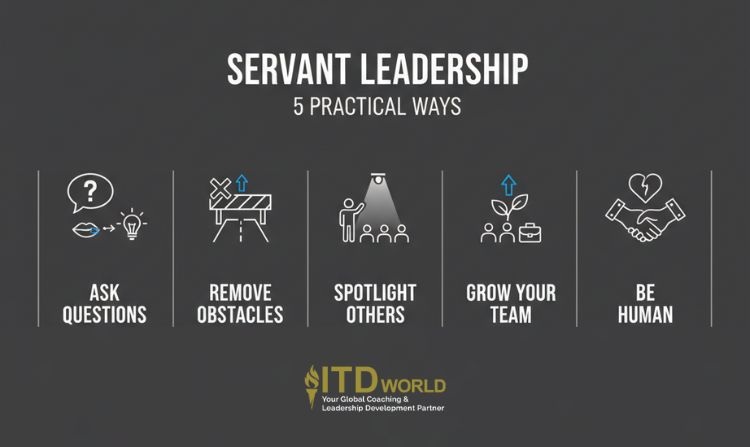Explore the art and science of servant leadership, plus a blueprint for applying this people-centric philosophy to the workplace.
In a business world that tends to equate leadership with power, authority, and top-down control, one of the most enduring management philosophies is built on a powerful paradox: the best way to lead is to serve. This is the essence of servant leadership, a time-tested approach that inverts the traditional pyramid to place the leader at the bottom, supporting their team. It is a profound shift in mindset from directing and controlling to empowering and developing, built on the belief that the most effective path to sustainable high performance is through a deep commitment to the growth and well-being of your people.
|
Author: Jonathan M. Pham |
Highlights
- Servant leadership is a philosophy where a leader’s main goal is to serve others and prioritize their growth and well-being, rather than seeking personal power or recognition. A pragmatic response to modern workplace demands, it plays a crucial role in increasing employee engagement, improving team performance, and enhancing customer satisfaction and reputation.
- Based on Robert K. Greenleaf’s work, Larry C. Spears identified ten key characteristics of a servant leader: listening, empathy, healing, awareness, persuasion, conceptualization, foresight, stewardship, commitment to the growth of people, and building community.
- To practice the philosophy, one should shift from providing answers to asking questions, actively remove obstacles for their team, highlight others’ achievements, prioritize individual growth, and embrace humility and vulnerability. For organizations, it is recommended that they systematically hire and promote individuals based on servant qualities, provide training and coaching in human-centric skills, and redefine performance metrics and rewards to prioritize people-centric outcomes alongside financial results.
- While servant leadership is sometimes criticized as being “weak” or leading to slower decision-making and leader burnout, it actually requires immense strength and can be effectively implemented by setting boundaries, delegating, and creating “pockets of excellence” even within a top-down culture.
What is Servant Leadership?
At its core, servant leadership is a leadership philosophy in which an individual’s primary motivation is a deep desire to cater to the needs of others. For a servant leader, the traditional markers of leadership – power, authority, and recognition – are not the goal, but rather the byproducts of their commitment to the growth and well-being of their team, organization, and community. They lead not to elevate themselves, but to lift up those around them.
The modern concept of servant leadership was formalized by Robert K. Greenleaf in his influential 1970 essay, “The Servant as Leader.” In his work, Greenleaf proposed a revolutionary test as follows:
The best test… is: do those served grow as persons; do they, while being served, become healthier, wiser, freer, more autonomous, more likely themselves to become servants?

For Greenleaf, the critical distinction was that a servant-leader is a servant first. The desire to serve is their primary motivation. The conscious choice to lead comes later as a way to expand that service to a wider group of people. This is fundamentally different from a person who is a leader first and then decides to adopt service as a leadership tactic.
This “serve first” philosophy differs significantly from traditional, hierarchical leadership models, which are typically built around the accumulation and exercise of power.
| Aspect | Traditional Leadership |
Servant Leadership
|
| Primary Motivation | The desire for power, authority, and control |
The desire to help others grow
|
| Main Focus | Directing people and managing tasks to achieve results |
Developing people and removing obstacles so they can achieve results
|
| Organizational Structure | A pyramid with the leader at the top |
An inverted pyramid with the leader at the bottom, supporting the team
|
While Greenleaf coined the term, the principles of servant leadership have been embodied by some of history’s most influential figures, including:
- Abraham Lincoln: Frequently cited for his humility and focus on healing a divided nation, Lincoln’s leadership during the U.S. Civil War was characterized by his desire to preserve the union and benefit the long-term well-being of the country, rather than seeking personal glory.
- Mahatma Gandhi: He led India to independence not through command and control, but through immense personal sacrifice and a deep commitment to supporting the needs of his people. He empowered millions to become agents of change themselves.
- Martin Luther King Jr.: His leadership was rooted in serving the cause of justice and equality for his community. He inspired a global movement by focusing on the needs, rights, and humanity of others, often at great personal risk.
- etc.

The Business Case for Servant Leadership
We are here on earth to make a positive difference, not to prove how smart or right we are.
Peter Drucker
The shift towards servant leadership is a pragmatic response to the realities of the modern workplace. In an era marked by a renewed focus on employee well-being and an intense “war for talent,” traditional command-and-control styles no longer work; the only thing they do is straining the relationship between individuals and their managers – which is, as identified by Gallup, a primary reason people leave their jobs.
On the other hand, organizations that successfully cultivate a servant leadership culture reap significant rewards that are backed by extensive research.
- Higher employee engagement: By prioritizing the needs of their team, servant leaders create an environment of psychological safety and high trust – the bedrock of engagement. In fact, research published in various academic journals has consistently shown a strong positive correlation between servant leadership and higher levels job satisfaction and organizational commitment.
- Improved team performance: When people feel supported and empowered, they are more willing to take risks and go the extra mile. A study featured in the Harvard Business Review noted that servant leadership fosters the conditions for team members to feel more proactive, which in turn fuels creativity, problem-solving, and overall performance.
- Enhanced customer satisfaction & reputation: There is a well-established “service-profit chain” where leaders serve their employees, who in turn provide exceptional service to customers. This translates to higher customer satisfaction and loyalty, which strengthens the brand’s reputation as a company that genuinely cares for both its people and its clients.
This philosophy is not merely theoretical; it is a core part of the operating model for some of the world’s most successful and respected companies:
- Marriott International: The global hospitality giant has operated for decades under the founding philosophy of J.W. Marriott: “Take care of associates and they will take care of the customers.” This servant-first mindset is a key reason Marriott has been consistently named one of Fortune’s “100 Best Companies to Work For.”
- Starbucks: The company refers to its employees as “partners” and has long been a leader in offering benefits like healthcare and college tuition assistance. Their focus on the well-being and growth of its people is a core tenet of servant leadership.
- TDIndustries: As a 100% employee-owned company, the firm is known for their “inverted pyramid” structure and stated core value to “Lead With a Servant’s Heart” – which have resulted in extremely low turnover and consistent recognition as one of the best places to work in America.
Applications of servant leadership
10 Characteristics of a Servant Leader
While servant leadership is a broad philosophy, its practice can be understood through a clear and actionable framework. After Robert K. Greenleaf first introduced the concept, scholar Larry C. Spears studied his writings extensively and identified ten key characteristics that are central to this people-centric approach.
More than simply hearing words, it involves a deep, genuine commitment to understanding the spoken and unspoken needs, concerns, and desires of the team. A servant leader listens intently and without judgment, seeking to clarify the will of the group.
Additionally, they strive to see the world from their team members’ perspectives and approaches them with compassion, assuming good intentions and acknowledging their unique circumstances.
Read more: The Importance of Emotional Intelligence in Leadership
- Healing
Servant leaders recognize that many people have been wounded by past experiences, both personal and professional. As such, they are committed to supporting the emotional and spiritual well-being of their team, creating a supportive environment where people may recover from setbacks and become whole.
- Awareness
This is the quality of being keenly aware of oneself and the world. A servant leader demonstrates high self-awareness – understanding their own strengths, weaknesses, and values – as well as a sharp perception of the broader context, including ethics and organizational dynamics.
Unlike traditional managers who tend to rely on positional authority, a servant leader influences others through clear, respectful persuasion. They are skilled at building consensus within a group, convincing others to act by appealing to a shared vision and logical arguments, not by issuing commands.
- Conceptualization
Specifically, it refers to the ability to think beyond day-to-day realities and articulate a clear, compelling vision for the future – one that inspires the team, helping them realize how their daily work contributes to a larger, meaningful purpose.
- Foresight
Foresight involves a blend of intuition and analysis that allows one to anticipate future events and their likely consequences. By learning from the past and understanding present realities, one may see potential roadblocks or opportunities before they become urgent problems.
- Stewardship
A servant leader feels a deep sense of stewardship, acting as a caretaker for the organization and its resources. They are committed to holding the institution in trust for the greater good of all stakeholders – employees, customers, and the community – not just for personal gain.
Read more: Spiritual Leadership – A Remedy for Today’s Workplace Woes
- Commitment to the growth of people
Servant leaders believe in the intrinsic value of every individual. They feel a personal responsibility to help their people develop and grow, both professionally and personally. As such, they will actively seek out coaching/ mentorship/ training opportunities for their team members, even if it means preparing someone for a role outside of their current team.
- Building community
This is the practice of fostering a true sense of belonging and connection within the workplace – by creating an environment where people feel safe, supported, and connected to one another on a personal level, not just as colleagues.
Read more: Leadership Values – 10 Qualities for Exceptional Results

How to Practice Servant Leadership
Understanding the characteristics of a servant leader is the first step; the real transformation happens when those qualities are translated into consistent, daily actions. For any leader looking to adopt this style, the journey begins with shifting personal habits and mindsets.
Below are five practical ways to put service into practice.
-
Shift from answering to asking
Most traditional managers feel their value comes from having all the answers. On the other hand, a servant leader finds value in unlocking the answers in others.
- Practice: Consciously resist the urge to provide immediate solutions. Instead, use powerful, open-ended questions to foster critical thinking in your team.
- Technique: Instead of saying, “Here’s how you should solve that,” ask questions like, “What are your thoughts on the best approach here?” or “What options have you considered?” Such a simple shift is crucial to cultivating your team’s problem-solving skills and demonstrates your trust in their judgment.
- Motto to stick by: Be a guide, not a guru.
-
Actively seek to remove obstacles
See your primary role as a “roadblock remover” whose job is to clear the path for your team to do their best work.
- Practice: Make it a habit to proactively discover what is hindering your team’s progress.
- Technique: In your one-on-one meetings, make it a standard question: “What’s getting in your way, and how can I help?” The obstacle could be a lack of resources, a conflict with another department, or unclear priorities – all of which a leader is uniquely positioned to solve.
- Golden rule: Your team’s success is your top priority.
-
Put the spotlight on others
A servant leader consciously deflects praise from themselves and shines it on their team, recognizing that success is a collective effort.
- Practice: Give credit freely, publicly, and specifically. For instance, instead of a general “good job, team,” say, “I want to recognize Sarah for her excellent data analysis, which was crucial for this decision, and Tom for his tireless work in coordinating with the client.” This validates individual contributions and builds team-wide morale.
- Motto to stick by: Celebrate the team, not the self.
-
Prioritize your team’s growth
View your team members as people with their own unique aspirations, not just as resources to complete tasks. A servant leader is deeply invested in the long-term growth of each person on their team.
- Practice: Dedicate time in every performance conversation to discuss career goals that may extend beyond their current role.
- Technique: Ask questions like, “What skills are you hoping to develop this year?” and then actively look for opportunities – a stretch assignment, a mentorship connection, a relevant training course – to help them achieve those personal goals.
- Golden rule: Develop people to leave, and they will have more reason to stay.
-
Practice humility and vulnerability
Trust is established when leaders are willing to be human and imperfect. In other words, you need to be willing to admit when you are wrong or don’t have the answer.
- Practice: Be the first to take accountability for a mistake. Saying something like “That’s a great question. I don’t have the answer right now, but I will find out and get back to you,” builds far more trust than pretending to be all-knowing. It makes it safe for others to be honest and ask for help.
- Motto to stick by: Be authentic, not perfect.
Read more: 12 Golden Leadership Principles for Attaining Excellence

Becoming a serving leader
Promoting a Culture of Servant Leadership
While individual leaders can create pockets of excellence, a truly servant-led organization is built through intentional, systemic effort. For the philosophy to become part of the company’s DNA, senior leadership and HR must create an ecosystem that actively fosters and rewards a service-oriented mindset.
-
Hire and promote for servant qualities
The foundation of a servant-led culture is getting the right people into management roles. This requires shifting hiring and promotion criteria to prioritize servant leadership competencies, not just technical skills or a history of individual achievement.
How-to: Incorporate behavioral questions into your leadership interview process that are specifically designed to reveal qualities like empathy, humility, and a focus on growing others.
Example: Instead of only inquiring about a candidate’s past business results, consider questions like, “Tell me about a time you put a team member’s development ahead of an immediate project deadline. What was the situation and the outcome?” or “Describe a time a subordinate strongly disagreed with you. How did you handle the conversation?”
-
Train and coach for service
Organizations cannot simply expect leaders to adopt this style without support. The characteristics of a servant leader – such as active listening, empathy, and giving developmental feedback – are sophisticated skills that must be taught and honed.
How-to: Invest in leadership development programs that are specifically designed around these human-centric skills. Provide ongoing support through professional coaching to help leaders work through the personal challenges of shifting from a directive to a service-oriented mindset.
-
Rethink how you measure and reward leaders
The principle “what gets measured gets done” is crucial here. If your organization only assesses and rewards individuals based on their team’s financial output, you will get leaders who prioritize output above all else. To create a true servant culture, you must expand your definition of a high-performing leader.
How-to: Incorporate servant leadership metrics into your formal performance management and compensation systems. A leader’s evaluation should include not only their team’s “what” (e.g., hitting sales targets) but also their “how.”
Example: Measure leaders on their team’s employee engagement scores, voluntary turnover rates, and the number of their direct reports who get promoted to other roles. When these people-centric metrics are tied to bonuses and promotions, the message from the organization becomes crystal clear: growing your people is a key indicator of your performance.
Read more: Executive Leadership – A Guide to Developing Tomorrow’s Titans

Addressing the Challenges and Criticisms of Servant Leadership
No management philosophy is a perfect solution for every situation, and servant leadership is not without its challenges. One of the most frequent criticisms is that the approach is “weak” or “soft” – specifically, various critics argue that a focus on serving can be misconstrued as being passive, indecisive, or an unwillingness to hold people accountable.
However, the reality is that practicing servant leadership requires immense personal strength, discipline, and courage. It takes far more confidence to listen to dissenting opinions than to silence them – more skill to hold someone accountable with empathy than to simply reprimand them. A true servant leader will make tough decisions – including letting people go who are detrimental to the team’s health – but they will do so with respect, clarity, and compassion.
Additionally, other potential problems one may face when adopting the philosophy includes:
- Slower decision-making
The process of actively listening to team members, gathering diverse input, and building consensus may sometimes be more time-consuming than a swift, top-down directive.
Mitigation: Servant leadership does NOT mean every decision is a democracy. The leader is still responsible for making the final call, especially on time-sensitive or strategic issues. The goal is not to achieve 100% consensus, but to make a decision that is informed by the team’s collective wisdom.
Example: One might frame a discussion by saying, “I need to make a final decision on this by 3 PM tomorrow. Between now and then, I want to hear everyone’s perspective and key concerns to ensure I am not missing anything.” This respects the team’s input while maintaining responsibility for a timely outcome.
Read more: Inclusive Leadership – Moving From Buzzword to Bottom Line
- The risk of leader burnout
Leaders who focus so intently on serving the needs of their team are likely to neglect their own well-being, leading to exhaustion and burnout.
Mitigation: Nobody can pour from an empty cup. Leaders must be disciplined about setting healthy boundaries, delegating effectively, and practicing self-care. By doing so, they not only protect their own well-being but also model a healthy and sustainable way of working for their entire team.
Read more: Leading by Example – Key to Truly Inspiring Action & Trust
- Difficulty implementing in a top-down culture
It is likely to be difficult for one to practice servant leadership when the broader organizational culture is strictly hierarchical and rewards command-and-control behavior.
Mitigation: The most effective approach is to “start where you are.” Even if the wider organization is traditional, a leader may still create a “pocket of excellence” within their own team. By consistently applying the principles of service, trust, and empowerment with their direct reports, they can build a high-performing, high-trust micro-culture. Often, the exceptional engagement and results produced by these teams become a powerful case study that influences the whole organization over time.
| Advantages | Disadvantages |
| Higher employee engagement |
Perceived as “weak” or “soft” (though it actually requires strength)
|
| Improved team performance |
Slower decision-making (due to seeking input)
|
| Enhanced customer satisfaction & reputation |
Risk of leader burnout (neglecting own well-being)
|
| Addresses “war for talent” issues |
Difficulty implementing in a top-down organizational culture
|
Servant leadership advantages and disadvantages

Read more: The Power of Introverted Leadership – Beyond the Stereotype
Servant Leadership Quotes
Check out more leadership quotes here!
The servant-leader is servant first. It begins with the natural feeling that one wants to serve, to serve first.
Robert K. Greenleaf
Leadership is not about being in charge. It’s about taking care of those in your charge.
Simon Sinek
The best way to find yourself is to lose yourself in the service of others.
Mahatma Gandhi
Good leaders must first become good servants.
Robert K. Greenleaf
Earn your success based on service to others, not at the expense of others.
H. Jackson Brown, Jr.
It’s an interesting equation: Less me + More them = Success.
People don’t care how much you know until they know how much you care.
Theodore Roosevelt
A leader is best when people barely know he exists, when his work is done, his aim fulfilled, they will say: we did it ourselves.
Lao Tzu
Respect the Divine and love people. (敬天愛人)
Kazuo Inamori – Kyocera’s management philosophy
Whoever would be first among you must be servant of all.
Matthew 20:26
Those who exalt themselves will be humbled, and those who humble themselves will be exalted.
Luke 14:11
Servant Leadership Books
- Servant Leadership in Action by Ken Blanchard & Renee Broadwell: A practical anthology featuring insights from top leaders like Brené Brown and Stephen Covey. It’s a great starter for understanding how the style works in real-world settings.
- The Power of Servant Leadership by Robert K. Greenleaf: A collection of essays from the founder of the servant leadership movement. It dives deep into the philosophy and its transformative potential for organizations.
- The World’s Most Powerful Leadership Principle by James Hunter: A concise guide for managers struggling with outdated management approaches. It emphasizes humility, service, and character as the foundation of effective leadership.
- The Serving Leader by Ken Jennings & John Stahl-Wert: A story-driven book that outlines five actionable principles to become a serving leader in an inspirational and practical manner.
- Servant Leadership: A Journey into the Nature of Legitimate Power and Greatness by Robert K. Greenleaf: The original classic that started it all, in which Greenleaf explores how true leadership begins with a desire to benefit others, not to wield power.
- The Servant by James C. Hunter: A compelling fable about a businessman who learns servant leadership at a monastery retreat.

Discover ITD World’s Leadeship Training Solutions
Embracing the principles of servant leadership is a transformative journey, both for an individual leader and for an entire organization. It requires a deep commitment to developing the human-centric competencies that build trust, foster engagement, and unlock the full potential of a team. While the journey is rewarding, it can be significantly accelerated with expert guidance and a structured approach.
At ITD World, we specialize in cultivating the very qualities that lie at the heart of this powerful leadership philosophy. Our programs are designed to move beyond theory and equip your leaders with the practical skills and mindsets needed to lead with a servant’s heart and a strategic mind.
We offer a range of solutions to support your journey toward a more people-centric culture:
- Public workshops: Our targeted workshops are designed to cultivate the core competencies of a servant leader, with a focus on essential ones like empathy, active listening, coaching for development, and giving effective feedback.
- Executive coaching: We provide confidential, one-on-one coaching for senior leaders who wish to refine their personal leadership style, navigate the challenges of a cultural shift, and authentically embody the principles of service in their daily actions.
- Customized in-house solutions: For organizations committed to promoting a servant leadership culture enterprise-wide, we partner with you to design and deliver bespoke, long-term programs that align with your unique values and drive systemic, sustainable change.
Ready to lead with purpose and build a team that is engaged, innovative, and high-performing? Contact ITD World today to learn how our solutions can help!
Other resources you might be interested in:
- Transformational Leadership: Inspiring Change & Growth
- Situational Leadership: Guide to Implementation
- Building a Lasting Leadership Legacy: Beyond the Title
- Talent Philosophy: Unlocking Workforce Potential & Driving Success
- Moving From the Golden Rule to the Platinum Rule
- Ego in the Workplace: The Hidden ‘Evil’ Behind Team Dysfunctions

